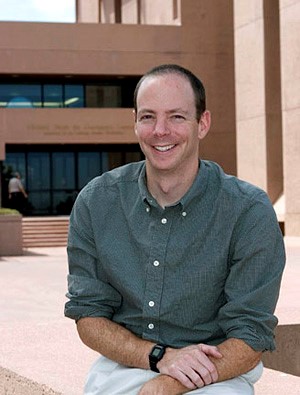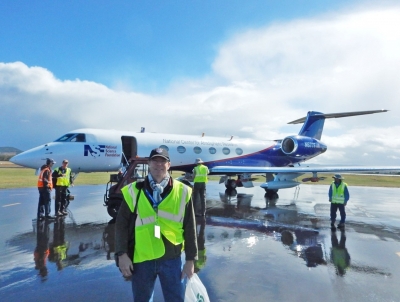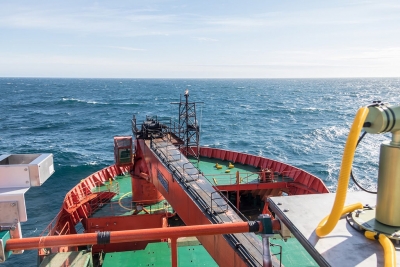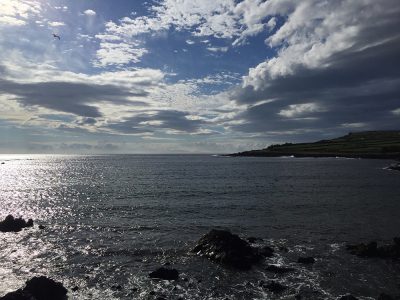UEC Profile: Combining Models With Observations, Andrew Gettelman Puzzles Out Cloud-Aerosol Interactions
Published: 19 June 2018
An active modeler calls himself ‘an evangelist’ for ARM data
This is the sixth article in a series of profiles on members of the ARM User Executive Committee (UEC).

“We model clouds pretty well, and we model aerosols pretty well,” says Andrew Gettelman, a scientist with the National Center for Atmospheric Research (NCAR) in Boulder, Colorado. “But we don’t model very well how they interact.”
That’s the core challenge that has informed the last 10 years of his career, and the one that has made Gettelman a believer in long-term observational data of the kind collected by the U.S. Department of Energy’s Atmospheric Radiation Measurement (ARM) user facility.
Such information, he says, brings the small scale and relative precision of weather forecasting to the challenge of informing and correcting earth systems models at regional and global scales.
“I’m an evangelist,” says Gettelman, an expert in cloud-aerosol interactions who develops and evaluates improvements to the NCAR’s Community Earth System Model and the global General Circulation Model. “I think a lot more people should be using ARM data.”
To back that up, the 20-year modeler is a member of ARM’s User Executive Committee, the official voice of the ARM user community. In that role, Gettelman sees himself as a conduit between a global community of large-scale modelers and experts on using such data.
“These are some of the only data sets of that quality that have been taken for 20 years and more now,” he says in praise of the high standards for collecting and archiving “baked into ARM’s DNA.”
Into the Clouds

“In the last five or 10 years, I have been a big consumer of observations, starting with satellites,” says Gettelman, who has served on several satellite science teams and who evaluates models through data analysis linked to both satellite and field programs.
Satellite data came first because of where his research interests began as a doctoral student in atmospheric sciences at the University of Washington, starting in 1994.
Gettelman arrived with an interest in the upper atmosphere and the chemistry of the stratosphere. From there, he says, “it’s been an evolution,” beginning with inquiries into the fate of stratospheric water vapor. Then he studied ice clouds, which he says led to an investigation of liquid clouds “to get a framework” for grasping a holistic view of cloud processes.
During and beyond his PhD, that led deeper into “understanding clouds and how they affect climate,” he says.
For Gettelman, that understanding comes chiefly through working at a desk, simulating clouds in a way that reveals their role in affecting earth systems.
He soon also grasped the necessity for modelers to get out into the field, meet the observationalists, and see how the data that underpin models are actually collected.
Gettelman traveled to Hobart, Australia, during the Measurements of Aerosols, Radiation, and Clouds over the Southern Ocean (MARCUS) field campaign from 2017 to 2018. It was part of a multi-agency research effort to give scientists a unique view of cloud-aerosol interactions within liquid and ice clouds in a pristine atmosphere, free of continental aerosol influences.
Around the same time as MARCUS, the National Science Foundation was flying a Gulfstream 5 research aircraft in a campaign called the Southern Ocean Clouds, Radiation, Aerosol Transport Experimental Study (SOCRATES). Gettelman got onboard.

“Everybody says we need more observations,” he says of the modeling community. “But be careful what you wish for. One minute I was at my desk and the next I was on an airplane, skimming over the Southern Ocean at 500 feet.”
For modelers, MARCUS and other recent Southern Ocean field campaigns were a boon. Uncertainties and biases (offsets from observations) have traditionally plagued simulations of Southern Ocean clouds, aerosols, and air-sea exchanges.
For one, present models “almost universally underestimate sunlight reflected by near-surface clouds,” according to MARCUS organizers. That reflects the well-known difficulty of representing supercooled and mixed‐phase clouds so pervasive in the marine boundary layer.
The hope is that new data from Southern Ocean research efforts may help correct future models.
Being out in the field is also for “understanding how observations are taken,” says Gettelman, who endured bumpy, low-altitude time aboard a Gulfstream 5 research aircraft operated by the National Science Foundation and NCAR.
“It’s not something I want to do all the time,” he says of field work. “It’s grueling and stressful. But it is important to confront our models with observations. To understand more means sticking your nose in the clouds.”
At other times, sticking your nose in clouds is also strongly scientific but vicarious. Gettelman has not visited the Azores yet, but he is on the science team for ARM’s Aerosol and Cloud Experiments in the Eastern North Atlantic (ACE-ENA) field campaign.
ACE-ENA is in the early stages of early observational analysis after wrapping up on-site work in February. It gathered data on low marine clouds, which are pervasive, influential, and so far poorly represented in models.

Either in the field or at his NCAR desk in Boulder, says Gettelman, “I am after clouds, wherever clouds are a problem for a model.”
For Starters, Reinforced Concrete
Gettelman arrived at Princeton University in 1988 wanting to study aerospace and mechanical engineering.
“But in the 1980s,” he recalls discovering, “aerospace meant building bombs.”
He soon turned to a major that at Princeton combined architecture and civil engineering, in part because of a course on the history of 20th century science policy. It included a look at the evolution of environmental science, from the exigencies of the Manhattan Project during World War II to the advocacies such science spurred later in the century.
“I was more attracted to environmental science, and its effect on public policy,” rather than the martial pursuits represented by modern-day iterations of the Manhattan Project, says Gettelman. (From his boyhood in Los Angeles came a minor inspiration in that direction too, he adds, remembering those days at school where outdoor play was forbidden because of air-quality alerts.)
By his senior year, Gettelman’s eclectic major required two final courses—one on Islamic architecture and the other on reinforced concrete.
The juxtaposition of those two courses was not jarring, he says. “I’ve always been doing different things, from the social impacts of climate change to hard-core cloud microphysics.”
For his senior thesis, Gettelman worked with postdocs at the Geophysical Fluid Dynamics Laboratory, a Princeton-based arm of the National Oceanic and Atmospheric Administration. His topic was scientific, but had policy implications: a statewide model of the effects of climate change on California.
“It was my first time doing research,” he says, “and my first time researching climate change.”
Soon, in Pursuit of ‘Stronger Science’
From 1992 to 1994, Gettelman worked on the policy side of environmental issues for the National Resources Defense Council in Washington, D.C.
Before long, “I was very interested in the science,” he says of the experience. “The policy was a little frustrating. You look at everything through a political lens.”
Instead, “I thought somehow science might solve the problem,” says Gettelman, “so I decided to get a stronger science background before I lost the desire and capability to do the math and physics of it.”
Then came the University of Washington, a doctorate in atmospheric sciences, and an eventual career at NCAR, where he is now a member of the atmospheric model development team and co-chair of the Whole Atmosphere Working Group of the Community Earth System Model.
Along the way, of course, there were honors and accomplishments: more than 150 peer-reviewed articles, a co-authored text book (Demystifying Climate Models), memberships on key advisory boards, and two posts as a visiting scholar: at the University of Christchurch in Canterbury, New Zealand, and at the Institute for Atmospheric and Climate Science at the Swiss Federal Institute of Technology in Zurich, Switzerland.
That’s a lot to owe to a course in reinforced concrete, perhaps, and to the wisdom (he says) to veer from policy back to science.
Gettelman is glad, reflecting on his decision almost 25 years ago to move from Washington, D.C. to the University of Washington. “The science has moved on. The policy has not.”
The ARM Climate Research Facility is a DOE Office of Science user facility. The ARM Facility is operated by nine DOE national laboratories.
Keep up with the Atmospheric Observer
Updates on ARM news, events, and opportunities delivered to your inbox
ARM User Profile
ARM welcomes users from all institutions and nations. A free ARM user account is needed to access ARM data.


















